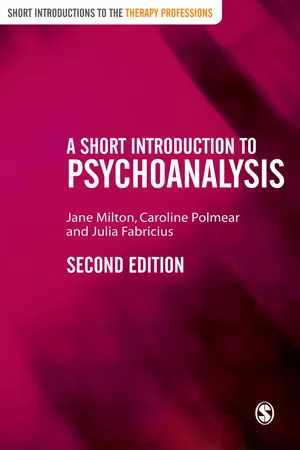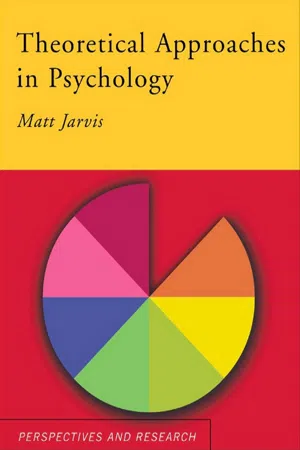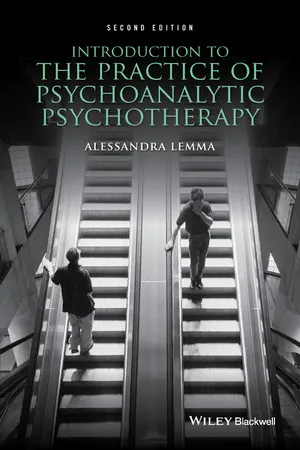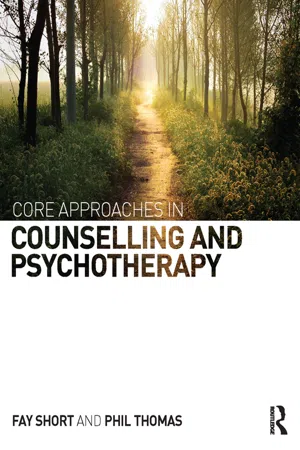Psychology
Psychoanalysis
Psychoanalysis is a psychological theory and therapy developed by Sigmund Freud. It focuses on exploring the unconscious mind and its influence on behavior and mental processes. The main techniques of psychoanalysis include free association, dream analysis, and transference, with the goal of bringing repressed thoughts and feelings to the conscious mind for resolution.
Written by Perlego with AI-assistance
Related key terms
9 Key excerpts on "Psychoanalysis"
- eBook - ePub
- Jane Milton, Caroline Polmear, Julia Fabricius(Authors)
- 2011(Publication Date)
- SAGE Publications Ltd(Publisher)
2 BASICS OF PSYCHOANALYTIC THEORY Psychoanalysis is a branch of psychology particularly concerned with subjective experience. It has three aspects. First, it is a body of knowledge about the mind, which has been discovered partly through the sort of work described in the previous chapter and partly through studying ordinary human phenomena such as dreams, slips (like slips of the tongue) and jokes. Second, the word ‘Psychoanalysis’ refers to a method for investigating the mind. Third, Psychoanalysis refers to a form of psychotherapeutic treatment. Psychoanalysis takes a dynamic rather than a static view of the mind, seeing movement, energy and in particular conflict as intrinsic to mental life. For example, a person may want to do something his or her conscience doesn’t allow, or may be pulled in different ways by love and hate for the same person. He or she may want to know the truth but also be frightened and reluctant to find out. Central to psychoanalytic theory is the idea that much of our mental life is unconscious. Unconscious thoughts, feelings and wishes form the mental bedrock, with conscious experience the tip of the iceberg. Unconscious processes cannot, by definition, be known directly but have to be inferred by their effects, analogous to the powerful but invisible effect of gravity. Psychoanalytic theory offers a developmental perspective. Although there are a number of partly overlapping and sometimes conflicting psychoanalytic theories of development, all emphasise the formative effect of early relationships. Early experience is seen as interacting with innate endowment in determining the way the mind forms. Normal development involves acquiring an increasingly clear and stable sense of self, and an increasing capacity to relate to others as separate and unique - Intelligent Education(Author)
- 2020(Publication Date)
- Influence Publishers(Publisher)
(A student once observed that a Freudian footnote was often worth more than chapters by other psychologists.) And one of the principal tasks of this brief work will be the attempt to help clarify just what Freudian Psychoanalysis is, and just what it is not. A monumental confusion abounds in the minds of students and professionals alike in attempting to distinguish the principles of Psychiatry and Psychotherapy. These terms are often used with a great deal of imprecision as interchangeable, which they are not! As a brief working definition of Psychoanalysis, the author proposes the following: Psychoanalysis is just what Freud says it is and nothing else. He himself felt bitter about the appropriation of the term made by C. G. Jung and others and argued in the Introductory Lectures and elsewhere that since he had made the fundamental discoveries of this revolutionary science of the mind, he and he alone was entitled to say what doctrines comprised Psychoanalysis. The stupendous discoveries of the unconscious mind, the Oedipus Complex, the nature of dreams, the etiology of the neuroses, infantile sexuality, and the origin and meaning of civilization’s most important institutions, religion, morality, the family, and art, plus the elaboration of a therapeutic technique which could uncover the most hidden recesses of the human psyche and alleviate the suffering of neurotically ill human beings, gave him the legitimate right, Freud argued, to demarcate the boundaries of the science of Psychoanalysis. Any psychology which claimed this august title for itself but at the same time denied the relevance of these discoveries simply was not Psychoanalysis. His biographer Dr. Ernest Jones has written that Freud’s discoveries must be studied chronologically in collaboration with a step-by-step discussion of the growth and changes in his personality- eBook - ePub
- Matt Jarvis(Author)
- 2005(Publication Date)
- Routledge(Publisher)
events to the unconscious mind, and by unconscious motives. Although consciously, Alex thought she was taking her sister to sea for a birthday treat, the event seems to have quite a different meaning to her unconscious mind. We might even wonder whether Alex was motivated on an unconscious level to take her sister to sea again in order to kill her.- In contrast to other branches of psychology which place a strong emphasis on systematic, scientific research,
psychodynamic psychology looks for information in dreams, symptoms, irrational behaviour and what patients say in therapy.(Adapted from Rycroft, 1968; Tavris and Wade, 1997; Jarvis, 2000)If you know very little about psychology, and you have heard of just one psychologist, the chances are that this is Sigmund Freud, the founder of the psychodynamic approach to psychology, or Psychoanalysis. If Freud (or at least Freud as he is popularly portrayed) represents your layperson’s idea of psychology then you probably have an image of a patient lying on a couch talking about their deepest and darkest secrets. In deliberate contrast to behavioural psychology, examined in Chapter 2 , psychodynamic psychology ignores the trappings of science and instead focuses on trying to get ‘inside the head’ of individuals in order to make sense of their relationships, experiences and how they see the world.In this chapter we can look at the work of Freud and that of one other influential psychoanalyst, Donald Winnicott. We can then look at how psychodynamic principles have been applied in the field of mental health, and use them to try to understand the popularity of monsters, a seemingly irrational phenomenon common throughout history and common to many cultures.Freud’s theories
Sigmund Freud (writing between the 1890s and the 1930s) developed a collection of theories which have formed the basis of the psychodynamic approach to psychology. His theories are clinically derived—i.e. based on what his patients told him during therapy. Freud theorised on a wide variety of topics and developed his ideas throughout the period of his writing. It is not possible to overview all or most of Freud’s ideas in this chapter, but we can look briefly at a few of Freud’s more important contributions. - eBook - ePub
Consumer Behaviour
Perspectives, Findings and Explanations
- John O'Shaughnessy(Author)
- 2012(Publication Date)
- Bloomsbury Academic(Publisher)
Chapter 5 Psychoanalytic Psychology BASIC CLAIMS Sigmund Freud (1856–1939) is the father of psychoanalytic psychology as well as Psychoanalysis. Psychoanalysis is tied to psychoanalytic psychology: witness how the Journal of Psychoanalytic Psychology describes itself as ‘the intersection of Psychoanalysis and psychology’. Psychoanalytic psychology denies that mental life is dominated by the conscious mind; Freud questioned the degree to which we know the motives lying behind our actions while arguing that people’s real motives and intentions remain hidden. Psychoanalysis, in turn, consists of both a set of techniques for discovering and exploring the underlying motives lying behind human behavior and as treatment for various mental disorders like neurosis. The paradigm of psychoanalytic psychology (Freudian psychology) imputes to behavior a perspective that makes claims for the role of the unconscious lying behind human behavior, an unconscious defined as consisting of happenings in the mind, of which the subject is entirely unaware. But there is an inherent vagueness in the way the concept of ‘unconsciousness’ is used in psychology generally. Searle (1992), a well-known analytic philosopher, argues that all talk in psychology about unconscious mental states and processes is simply talk about dispositional states; that is, we are disposed to believe this or want that, while talk about unconscious mental states that are, even in principle, inaccessible can be shown to be incoherent. The term ‘unconscious’ in psychology, at a minimum, means ‘outside of awareness’, as perhaps are dispositional states, so Searle’s view is defensible - Alessandra Lemma(Author)
- 2015(Publication Date)
- Wiley-Blackwell(Publisher)
2 An Overview of the Schools of Psychoanalysis: Theory and PracticeI. Theory
Psychoanalysis in Context
Psychoanalysis is often approached critically by those who are not involved with it. This is partly because it is perceived as an exclusive, precious club whose membership consists of people who regard themselves as having access to truths about human nature and the process of psychotherapy that are lost on the average non-psychoanalytic clinician. There is some truth in this perception, but it is not altogether accurate as the psychoanalytic membership includes a broad range of people with different values and attitudes. Its membership is in some respects incontrovertibly privileged: it consists mostly of people who are sufficiently socio-economically advantaged to undertake a lengthy training that requires a second mortgage. There is little doubt too that Psychoanalysis has all too often adopted a dismissive – even arrogant – attitude to related fields of enquiry and to other therapeutic modalities. Nowadays, psychoanalytic training institutions are acutely aware of the dwindling numbers in the applications to train psychoanalytically. Keenness to recruit more students into the analytic fold has contributed to a much-needed review of admission procedures and the content and process of training.Psychoanalysis is currently negotiating a transitional phase. Entrenched theoretical positions, perhaps owing more to political agendas than anything else, are gradually being challenged and opened up for evaluation. Cross-fertilisation of ideas between different schools and between different disciplines is gaining momentum. This change is exciting and unsettling: some practitioners are reaching out for the new while others remain fiercely attached to cherished assumptions, seemingly impervious to what other fields of enquiry might have to Psychoanalysis.- eBook - ePub
- Allan Tasman, Jerald Kay, Jeffrey A. Lieberman, Michael B. First, Mario Maj(Authors)
- 2011(Publication Date)
- Wiley(Publisher)
2. that unresolved conflicts between these early needs and prohibitions, as well as early traumas, although not available to conscious recall, motivate adult behavior and cause symptom formation in mental illnesses. This process of motivation by unconscious mental content is called the ‘dynamic unconscious’ (“Three Essays on Sexuality,” Freud 1953). Anxiety is the affect that signals the presence of an unresolved unconscious conflict.3. that patients in psychotherapy reenact their earliest relationships in their relationship with the therapist—called the transference. Freud discovered that the transference and its interpretation by the analyst played a central role in the therapeutic process.4. that the mental mechanism of repression operates to prevent conscious awareness of early conflicts over prohibited desires.5. that the resolution of conflicts arising from the Oedipus complex, the child’s triangulation of relations between its mother and father and himself (and a parallel complex in girls), plays a central role in directing development towards healthy or maladaptive outcomes.6. that the patient’s free association to memories, fantasies, and dreams, told to the therapist as they occurred, and the therapist’s interpretation of these, was the most effective therapeutic method to bring repressed unconscious conflicts into consciousness, resolve them, and thereby relieve mental symptoms.These observations and hypotheses were the foundation of a revolutionary new understanding of mental life and human behavior. Following the logic of basic research, Freud developed a mechanistic and reductionist “metapsychology,” to provide a conceptual framework for the observations and hypotheses that he had formulated in the consulting room. These include the familiar concepts of libido, the source of mental energy and drives; the structural theory of the mind, which postulated the existence of the id, ego, and superego, which contain the unconscious drives and prohibitions; and the pleasure principle, a homeostatic mechanism that underlies all mental activity and aims at maximizing pleasure and minimizing unpleasure by reducing libidinal tension. Freud called both the new therapy and its metapsychological conceptualization Psychoanalysis. - eBook - ePub
Introducing Psychoanalysis
A Graphic Guide
- Ivan Ward, Oscar Zarate(Authors)
- 2014(Publication Date)
- Icon Books Ltd(Publisher)
It has not been established that major differences exist between treatment outcomes for Psychoanalysis and less intensive forms of psychotherapy, with fewer sessions per week and shorter duration of treatment. Psychoanalysis is the paradigm psychotherapy but it can go on for five days a week for many years.SOME PEOPLE SEEM TO BE SUITED TO THIS KIND OF PROCESS.OTHERS WOULD FIND IT IRKSOME.WHY DO SOME PATIENTS GET BETTER WITHOUT TREATMENT?A psychoanalyst might say that a patient’s “spontaneous” recovery does not just come out of thin air; it’s not spontaneous generation. It shows that there is a certain amount of “psychical work” going on, an internal therapeutic process.The concept of “work” is fundamental to Psychoanalysis. The psychoanalyst and the patient have to decide whether they can “work together”. The process of achieving therapeutic change is called “working through”. The psychoanalyst Paula Heimann called the nightly process of dreaming (the “dream-work”) a spontaneous therapy , and also the play of humour and joking (Freud’s “joke-work”), or creativity.WHY CAN ALL THESE THINGS BE THERAPEUTIC?BECAUSE THEY ACCESS ELEMENTS OF THE UNCONSCIOUS, FREE THEM UP AND ALLOW THEM TO BE UTILIZED BY THE SUBJECT.It could be said that “spontaneous recovery ” is a confirmation of psychoanalytic therapy, rather than a refutation of it!Psychoanalytic therapy is not a big mystery. It uses propensities and capabilities that are available to everyone.The Influences of Psychoanalysis
But Psychoanalysis is more than a therapy. As a science of the unconscious, it is pertinent to all aspects of human reality in which the unconscious plays a part. And it has influenced the 20th century deeply as an idea, a theory and a practice.Psychoanalysis has applied itself to the study of the most varied aspects of cultural life.FROM FAIRY STORIES TO HOUSING PROBLEMS IN SOWETO; FROM FOOTBALL TO THE NUCLEAR BOMB …There are four kinds of influence, direct and indirect, which Psychoanalysis has had on the cultural life of modern societies.Childcare and Education
There is a direct influence on practices such as childrearing and education. In childcare, the emphasis has shifted from “controlling” and “moulding” children, to “nurturing” and “facilitating” their development within safe “boundaries”. In education, teachers may come to realize that the quality of the relationship with their pupils is just as important as the content of lessons for influencing their eagerness to learn. - eBook - ePub
- Naomi Moller, Andreas Vossler, David W Jones, David Kaposi, Naomi Moller, Andreas Vossler, David W Jones, David Kaposi(Authors)
- 2020(Publication Date)
- SAGE Publications Ltd(Publisher)
Chapter 3 ) was also the discovery of a very special kind of listening process, and a special type of psychic reality. The distinguishing features of the contemporary psychodynamic approach remain in keeping with these discoveries, despite many important changes in theory and practice. The psychodynamic approach continues to posit that, to alleviate mental distress, the therapist must engage with a directly inexpressible, dynamic unconscious realm of mental life, which originates in the vicissitudes of highly charged early experiences of love and hate.This chapter aims to:- introduce the central psychodynamic concept of unconscious communication
- introduce the origins of the dynamic unconscious and explain how it can inform our understanding of mental health
- outline the process of psychodynamic therapy – how unconscious communication may manifest and how it can be dealt with in therapy
- discuss the psychodynamic approach’s relationship to outcome research.
1 Core psychodynamic principles and their development
The development of the psychodynamic approach entailed a progressive expansion of the realm of unconscious communication, through which consciously inexpressible feelings of love and hate are communicated and understood.Unconscious communication Unintentional acts by which directly inaccessible psychic states are expressed.Freud’s treatment of reminiscences continued with the clients’ memories themselves, which he took to mean something more than what appeared on the surface. First, he traced troubling memories of relatively recent origin back to early traumatic experiences. Then, he considered how these early experiences themselves expressed more than what they seemed to – Freud understood the memories of early experiences as representing not simply historical truth (objective events that happened between parent and child) but also traumatising infantile impulses (the fears and desires central to the Oedipus complex, as outlined in Chapter 3 - eBook - ePub
- Fay Short, Phil Thomas(Authors)
- 2014(Publication Date)
- Routledge(Publisher)
This chapter aims to introduce the reader to the psychodynamic approach to counselling and psychotherapy. Psychoanalytic therapy will be explored as one example of a therapeutic method under the psychodynamic approach.LEARNING OUTCOMES By the end of this chapter, you will be able to:• describe the development of the second force in psychology: the psychodynamic approach• acknowledge the relative impacts of Sigmund Freud and Melanie Klein on the development of the psychodynamic approach• discuss the core theories of human nature and personality from the psychodynamic perspective• discuss the nature of the therapeutic relationship between therapist and client in psychoanalytic therapy• outline the main therapeutic techniques utilised in psychoanalytic therapy• appreciate the application of psychoanalytic therapy in a real-world settingDEVELOPMENT OF THE PSYCHODYNAMIC APPROACH
LEARNING OUTCOMES After reading this section, you will be able to:• list the three main forces in psychology• discuss the development of the psychodynamic approach in a historical context• acknowledge the main contributors to the development of the psychodynamic approachSecond force in psychology
Three forces in psychology Behavioural theory Psychodynamic theory Humanistic theory Psychodynamic psychology is the ‘second force’ Developed alongside the behavioural approach as the two reacted against one another
Learn about this page
Index pages curate the most relevant extracts from our library of academic textbooks. They’ve been created using an in-house natural language model (NLM), each adding context and meaning to key research topics.








